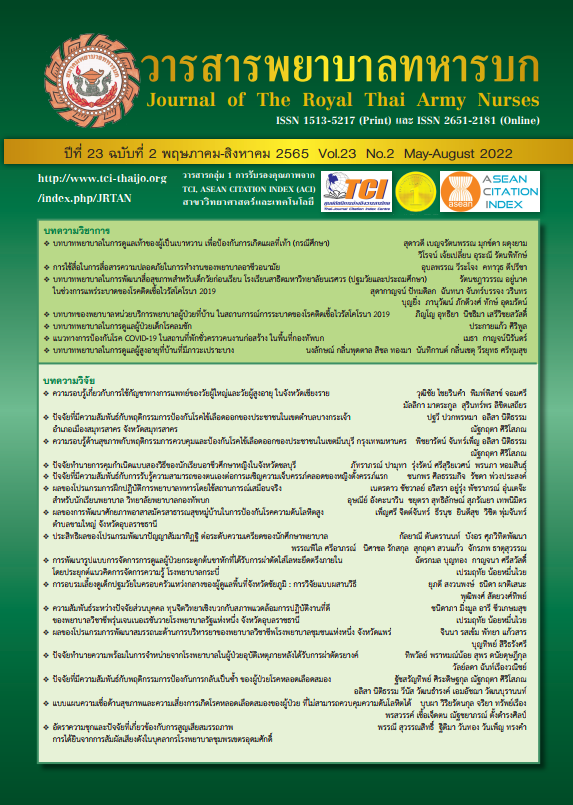Innovation Development Vibrate for Drainage Secretion of Pediatric Patients
Keywords:
Vibration, 2-to-5-year-old children, Drainage Secretion, Pediatric Patients, innovationAbstract
The purposes of this research were to develop an innovative vibrate for drainage secretion of pediatric patients and study satisfaction and quality assessment of the innovation. A process of an innovative vibrate for drainage secretion of pediatric patients consisted of two parts. The first one was the process of developing an innovative vibrate for drainage secretion of pediatric patients and The second one was study of satisfaction and quality assessment of the innovation among caregivers. Samples were 30 caregivers who had child 2-5 years at Pa Ngae community, Pa Ngae sub-district, Pa Daet district, Chiang Rai Province and welcome to use the innovation. They respond a questionnaire including satisfaction (IOC =0.79 and α = .80) and quality assessment of the innovation (IOC =0.80 and α = .80). Data analysis was descriptive statistics. The results showed 1) innovative vibrate for drainage secretion of pediatric patients and 2)means of satisfaction and of quality assessment of the innovation. The study showed the development of an innovative vibrate for drainage secretion of pediatric patients innovation included instruction and motor and control of vibration system. Means of satisfaction were much more ( = 3.54 - 3.80, SD = 0.50 - 0.70) and means of quality assessment of the innovation were also much more (
= 3.65 - 3.75, SD = 0.60 - 0.70). Therefore, the development of an innovative vibrate for drainage secretion of pediatric patients is appropriate for use. For future study, the development of an innovative vibrate for drainage secretion of pediatric patients should be used with more number of pediatric patients with secretion obstruction and compare with other innovative vibrators to assess the effectiveness.
Downloads
References
World Health Organization. Global action plan for the prevention and control of noncommunicable diseases 2013-2020. Geneva: World Health Organization; 2013.
The Thai society of pediatric respiratory and critical care medicine. Pneumonia. In: The Thai society of pediatric respiratory and critical care medicine, editors. Guideline for acute respiratory infection of pediatric 2019. Nonthaburi:Beyond enterprise company; 2019. (In Thai).
Niyomwit K. & Khammarit S. Nursing Care for Reducing Secretion Retention in Pediatric Patients. Journal of Phrapokklao Nursing College. 2019; 30(1): 216-225. (in Thai).
Supsung A, Jintrawet U. & Lumchang S. Factor Related to Caregiver Practices in Caring for Hospitalization Toddler with Acute illness. Journal of The Royal Thai Army Nurses. 2017; 18(2): 140-148. (in Thai).
Koonwiang E, Prabpai S. & Chanthong P. Effectiveness of Health Education Program for Prevention of Respiratory Infection among children with a cyanosis Congenital Heart Disease. Journal of The Royal Thai Army Nurses. 2017; 18(2): 140-148. (in Thai).
Wang TH, Wu CP. & Wang LY. Chest physiotherapy with early mobilization may improve extubation outcome in critically ill patients in the intensive care units. Clin Respir J. 2018; 11(2): 2613-2621.
Castro AM, Calil SR, Freitas SA, Oliveira AB. & Porto EF. Chest physiotherapy effectiveness to reduce hospitalization and mechanical ventilation length of stay, pulmonary infection rate and mortality in ICU patients. Respiratory Medicine. 2017; 107(1): 68-74.
Hussein HA. & Elsamman GA. Effect of Chest Physiotherapy on Improving Chest Airways among Infants with Pneumonia. Journal of American Science. 2017; 7(9): 460-466.
Morrow BM. Chest Physiotherapy in the Pediatric Intensive Care Unit. Journal of Pediatric Intensive Care. 2018; 4(4): 174-9.
Shannon H, Stiger R, Gregson RK, Stocks J. & Main E. Effect of chest wall vibration timing on peak expiratory flow and inspiratory pressure in a mechanically ventilated lung model. physiotherapy. 2017; 96(1): 344-349.
McCarren B, Alison JA. & Herbert RD. Vibration and its effect on the respiratory system. Australian Journal of Physiotherapy. 2017; 52(1): 39-43.
Kluayhomthong S, Khrisanapant W, Chaisuksant S. & Jones C. Effectiveness of a new breathing device “BreatheMAX®” to increase airway secretion clearance in patients with ventilatory dependence. Journal of Medical Technology and Physical Therapy 2017, 23(1): 95-108. (in Thai).
Volsko TA. Airway Clearance Therapy: Finding the Evidence. Respiratory care. 2017; 58(10): 1669-1678.
Prajankett O, Indhraratana A, Prasittivejchakul A. & Julawong O. The Effect of Research Based Learning Management in Health System and Health Promotion Subject on Learning Outcome and Innovative Work Behavior of Nursing Students. Journal of The Royal Thai Army Nurses. 2017; 18(2): 55-63. (in Thai).
Pongcharoen C, Luk-in C, Siratirakul L. & Panasan D. The effects of using the innovative suction model“SNC. SUCTION MODEL” on suction skills of nursing students. Journal of Nursing and Health Research. 2017; 22(1): 80-94. (in Thai).
Jaigarun P, Hongthong A, Mayotha O, Kankoa A, Watchakan A. & Pariyathai O. Innovation: Duk-Dik Shlrt. Journal of Health Science Boromarajonani College of Nursing Sunpasitthiprasong 2017; 2(1): 48-62. (in Thai)
Downloads
Published
How to Cite
Issue
Section
License
Copyright (c) 2022 Journal of The Royal Thai Army Nurses

This work is licensed under a Creative Commons Attribution-NonCommercial-NoDerivatives 4.0 International License.
บทความหรือข้อคิดเห็นใดใดที่ปรากฏในวารสารพยาบาลทหารบกเป็นวรรณกรรมของผู้เขียน ซึ่งบรรณาธิการหรือสมาคมพยาบาลทหารบก ไม่จำเป็นต้องเห็นด้วย
บทความที่ได้รับการตีพิมพ์เป็นลิขสิทธิ์ของวารสารพยาบาลทหารบก
The ideas and opinions expressed in the Journal of The Royal Thai Army Nurses are those of the authors and not necessarily those
of the editor or Royal Thai Army Nurses Association.






